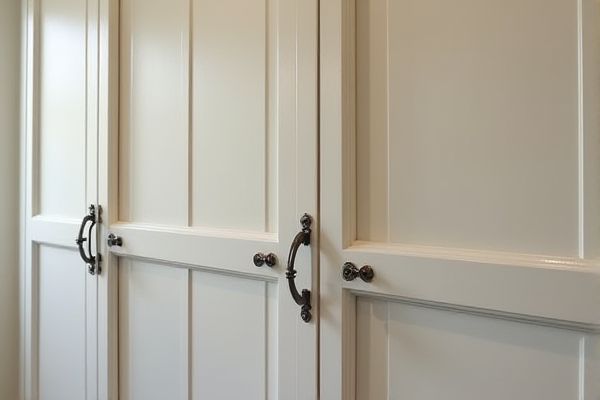
Concealed hinge pantry doors offer a sleek, modern look by hiding hardware within the door frame, enhancing your kitchen's clean aesthetic and providing smoother operation compared to exposed hinges. To explore the benefits and drawbacks of each option for your pantry, read the rest of the article.
Table of Comparison
| Feature | Concealed Hinges | Exposed Hinges |
|---|---|---|
| Appearance | Hidden for a clean, modern look | Visible, adds decorative or traditional style |
| Installation | Requires precise recess mounting | Simple surface mounting |
| Adjustability | 3-way adjustment (height, depth, side) | Limited or no adjustment |
| Durability | Protected from damage, lasts longer | Exposed to wear and possible damage |
| Cost | Generally higher cost | Typically lower cost |
| Maintenance | Less frequent cleaning needed | Requires regular cleaning to avoid rust |
| Door Movement | Smooth, soft-close options available | Varies, often lacks soft-close |
Introduction to Concealed vs Exposed Hinge Pantry Doors
Concealed hinge pantry doors offer a sleek, modern appearance by hiding hardware within the cabinetry, enhancing clean lines and minimalist design. Exposed hinges, commonly found in traditional or rustic kitchens, provide a decorative element and are easier to adjust or replace. Choosing between concealed and exposed hinges impacts both aesthetics and functionality of pantry doors, influencing maintenance and overall kitchen style.
Design Aesthetics: Sleek vs Traditional Looks
Concealed hinge pantry doors offer a sleek, modern design aesthetic by hiding hardware completely, creating smooth and uninterrupted surfaces that enhance minimalist interiors. Exposed hinges provide a traditional look, adding decorative detail and character that complement classic or rustic kitchen styles. Choosing between concealed and exposed hinges depends on the desired visual impact and overall kitchen decor theme.
Space Optimization and Door Functionality
Concealed hinge pantry doors maximize space optimization by allowing doors to close flush with cabinet frames, eliminating protruding hardware that can obstruct movement in tight kitchens. These hinges enhance door functionality through smooth, silent operation and full overlay options that improve cabinet accessibility. Your kitchen benefits from a streamlined look and efficient use of space with concealed hinges compared to exposed hinges, which can limit door swing and reduce available room.
Installation Process: Ease and Challenges
Concealed hinge pantry doors require precise mortising for installation, offering a sleek, modern look but demanding careful alignment to ensure smooth operation. Exposed hinges are generally easier to install, as they mount directly onto the door surface without additional recessing, making adjustments simpler during setup. Your choice impacts installation time and complexity, with concealed hinges requiring more skill but delivering a cleaner aesthetic.
Durability and Maintenance Requirements
Concealed hinge pantry doors offer superior durability as their mechanisms are protected from dust, moisture, and physical damage, reducing wear over time. These hinges require minimal maintenance due to their hidden placement, preventing rust and ensuring smooth operation without frequent adjustments. Exposed hinges, however, are more vulnerable to environmental factors and may need regular cleaning and lubrication to maintain functionality and appearance.
Cost Comparison: Concealed vs Exposed Hinges
Concealed hinge pantry doors generally cost more upfront than exposed hinges due to their complex installation and sleek design. Exposed hinges offer a budget-friendly option with simpler hardware that is easier to replace and maintain. Your choice impacts both initial expense and long-term durability, with concealed hinges providing a modern aesthetic while exposed hinges prioritize affordability.
Accessibility and Everyday Use
Concealed hinge pantry doors offer a sleek design that enhances accessibility by allowing doors to open smoothly without visible hardware obstructing the space, making everyday use more convenient and streamlined. Exposed hinges, while often easier to adjust and maintain, can limit full door swing and may catch on objects or clothing during frequent use. Your choice affects the ease of access and how seamlessly you interact with your pantry in daily routines.
Compatibility With Different Pantry Styles
Concealed hinge pantry doors offer seamless integration with modern and minimalist pantry styles, enhancing a clean and streamlined appearance. Exposed hinges tend to complement traditional, rustic, or farmhouse designs, providing a decorative element that adds character to the pantry. Compatibility depends on the desired aesthetic and practical considerations, with concealed hinges favoring subtlety and exposed hinges emphasizing hardware as a design feature.
Security and Adjustability Features
Concealed hinge pantry doors offer enhanced security by hiding the hinge mechanism, making tampering or forced entry more difficult compared to exposed hinges. These hinges also provide superior adjustability, allowing precise alignment and easy realignment over time to maintain a flawless door fit. You benefit from a cleaner aesthetic and improved durability, as concealed hinges protect moving parts from dust and damage.
Making the Right Choice for Your Home
Concealed hinge pantry doors offer a sleek, modern aesthetic and improved space efficiency by hiding hardware within the door frame, enhancing your kitchen's streamlined look. Exposed hinges provide easier access for adjustments and repairs, often adding a decorative, traditional element to your cabinetry. Evaluating your kitchen style, maintenance preferences, and how you use your pantry will help you make the right choice for your home.
 homyna.com
homyna.com